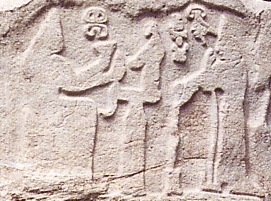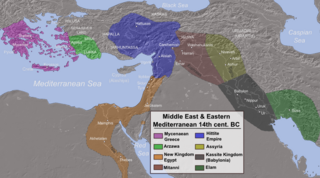
The Hittites were an Anatolian people who played an important role in establishing an empire centered on Hattusa in north-central Anatolia around 1600 BC. This empire reached its height during the mid-14th century BC under Šuppiluliuma I, when it encompassed an area that included most of Anatolia as well as parts of the northern Levant and Upper Mesopotamia.

Tunna, also Dunna or Atuna, was an ancient Anatolian city. In classical antiquity Tunna was known as Tynna. Today it is known as Porsuk Hüyük or Zeyve Höyük.

Yamhad was an ancient Semitic kingdom centered on Ḥalab (Aleppo), Syria. The kingdom emerged at the end of the 19th century BC, and was ruled by the Yamhadite dynasty kings, who counted on both military and diplomacy to expand their realm. From the beginning of its establishment, the kingdom withstood the aggressions of its neighbors Mari, Qatna and Assyria, and was turned into the most powerful Syrian kingdom of its era through the actions of its king Yarim-Lim I. By the middle of the 18th century BC, most of Syria minus the south came under the authority of Yamhad, either as a direct possession or through vassalage, and for nearly a century and a half, Yamhad dominated northern, northwestern and eastern Syria, and had influence over small kingdoms in Mesopotamia at the borders of Elam. The kingdom was eventually destroyed by the Hittites, then annexed by Mitanni in the 16th century BC.

Hittite, also known as Nesite and Neshite, was an Indo-European language that was spoken by the Hittites, a people of Bronze Age Anatolia who created an empire, centred on Hattusa, as well as parts of the northern Levant and Upper Mesopotamia. The language, now long extinct, is attested in cuneiform, in records dating from the 16th to the 13th centuries BCE, with isolated Hittite loanwords and numerous personal names appearing in an Old Assyrian context from as early as the 20th century BCE.

The Hattians were an ancient people who inhabited the land of Hatti in central Anatolia. The group was documented at least as early as the empire of Sargon of Akkad, until it was gradually absorbed c. 2000–1700 BC by the Indo-European Hittites, who were subsequently associated with the "land of Hatti".
Mursili I was a king of the Hittites c. 1620-1590 BC, as per the middle chronology, the most accepted chronology in our times, or alternatively c. 1556–1526 BCE, and was likely a grandson of his predecessor, Hattusili I. His sister was Ḫarapšili and his wife was queen Kali.

Hattusili III was king of the Hittite empire c. 1267–1237 BC.
Mursili II was a king of the Hittite Empire c. 1321–1295 BC.

Kussara (Kuššar) was a Bronze Age kingdom in Anatolia. The kingdom, though apparently important at one time, is mostly remembered today as the origin of the dynasty that would form the Old Hittite Kingdom.
Kuzi-Teshub was a Neo-Hittite King of Carchemish, reigning in the early to mid-12th century BC, likely in 1180-1150 BC. He was the son of Talmi-Teshub, who was both the last viceroy of the Hittite Empire at Carchemish under Suppiluliuma II and a direct descendant of Suppiluliuma I. Kuzi-Teshub reigned in Carchemish as well as in the later Neo-Hittite city of Melid.

Puduḫepa or Pudu-Kheba was a Hittite queen married to the King Hattusili III. She has been referred to as "one of the most influential women known from the Ancient Near East."
Huzziya II was a king of the Hittites. He was killed by Muwatalli I, who seized the throne and was possibly the Gal Mesedi of the royal bodyguard.

The Egyptian–Hittite peace treaty, also known as the Eternal Treaty or the Silver Treaty, is the only ancient Near Eastern treaty for which both sides' versions have survived. It is the earliest known surviving peace treaty and is sometimes called the Treaty of Kadesh after the well-documented Battle of Kadesh fought some sixteen years earlier, although Kadesh is not mentioned in the text. Both sides of the treaty have been the subject of intensive scholarly study. The treaty itself did not bring about a peace; in fact "an atmosphere of enmity between Hatti and Egypt lasted many years," until the eventual treaty of alliance was signed.
The gal gestin was a Hittite military and administrative title literally meaning "chief of the wine stewards". It is considered to be one of the most important and prestigious posts of the Hittite Kingdom.
The gal dubsar was a Hittite administrative title literally meaning "chief of the scribes". It is considered to be one of the most important and prestigious posts of the Hittite Empire as the gal dubsar was the head of the government.
Zippalanda was a Hattic administrative and religious center of the Hittite Old Kingdom. Although its name was known from inscriptions, it was not until the latter 20th century that scholars placed it in Sorgan District of Yozgat Province, Turkey, near Kerkenes Dağ, about one day's journey north of Ankuwa. The plausible sites are the settlement mounds known as Çadır Mound and Uşaklı Mound.

Attarsiya was a 15th–14th century BCE military leader of Ahhiya. In the Hittite archives of circa 1400 BCE, he is described as a "man of Ahhiya", a country identified with the Achaeans and Mycenaean Greece. The campaigns of Attarsiya, as well as his conflict with the Hittite vassal, Madduwatta, represent the first recorded Mycenaean Greek military activity on the Anatolian mainland, as well as the first conflict between Achaeans and Hittites. He finally withdrew from Anatolia after Hittite intervention, but later launched a campaign against Alashiya (Cyprus).
The Mesedi was the personal bodyguard of the king of the Hittites. The Mesedi was led by the Gal mesedi, who held considerable prestige in Hittite society. The Mesedi were a unit of 12 spearmen who protected the king wherever he might go. They probably numbered more in total in order to protect the king at all hours. They were reinforced and probably monitored by another unit numbering 12, known as the "golden spearmen." The Mesedi's purpose was the protection of the king against assassinations, which was endemic to the Hittite nobility. They also played a prominent role during festivals.
Hartapu was a late Hittite king who reigned in Tarhuntassa in the 13th Century BCE. He is known from Hieroglyphic Luwian inscriptions from Kizildağ, Mount Karadağ, and Burunkaya near Aksaray. His recently discovered monumental stele claimed victory over the kingdom of Phrygia, ruled around that time by King Midas.
Adad-Nirari or Addu-Nirari was a king of Nuhašše in the 14th century BC. His identity and succession order is debated as well as the extent of his kingdom which might have included Qatna. Adad-Nirari engaged in a military struggle again the Hittite king Šuppiluliuma I, asking Egypt for help and invading the kingdom of Ugarit, a Hittite vassal. Those actions prompted Šuppiluliuma to invade the region and relive Ugarit. Adad-Nirari's fate is unknown as he disappeared from records.